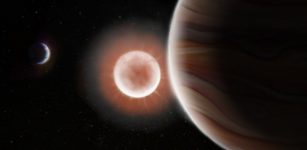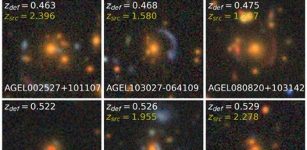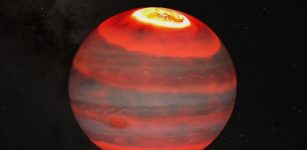Milky Way’s Central Supermassive Black Hole Shows Elongated Structure
Eddie Gonzales Jr. – MessageToEagle.com – A research team led by Assistant Professor Makoto Miyoshi from the National Astronomical Observatory of Japan re-analyzed data on the Milky Way’s supermassive black hole from the Event Horizon Telescope.
They found it slightly elongated east-west.
Final image of Sgr A* obtained from our imaging process. Credit: Monthly Notices of the Royal Astronomical Society (2024). DOI: 10.1093/mnras/stae1158
This research, published in the Monthly Notices of the Royal Astronomical Society, takes a new look at the publicly available EHT data and demonstrates the scientific process in which the certainty of the answer increases as different researchers continue to examine and discuss a theory.
The Milky Way galaxy, in which we live, contains more than 100 billion sun-like stars. There are countless such large galaxies in the universe, most of which are thought to have supermassive black holes at their centers with masses millions to billions of times that of the sun. The Milky Way galaxy also has a supermassive black hole at its center, called Sagittarius A* (A star).
The black hole swallows everything, including light, making it impossible to see the supermassive black hole itself, but analysis of stars circling the black hole at high speed indicates that Sagittarius A* has a mass approximately 4 million times that of the sun. By closely observing its surroundings, we can obtain clues to the nature of the invisible black hole.
The EHT observed Sagittarius A* in 2017 with a network of eight ground-based radio telescopes using a technique known as radio interferometry to combine the results from the various telescopes. The results of these observations were published in 2022, including an image of a bright ring structure surrounding a central dark region, indicating the presence of a black hole.
In contrast to typical photography, data from observations linking several widely-separated radio telescopes contain many gaps in the completeness, so special algorithms are used to construct an image from the data. In this research, the team applied widely-used traditional methods to EHT data, as opposed to the EHT’s own original analysis method.
Miyoshi explains, “Our image is slightly elongated in the east-west direction, and the eastern half is brighter than the western half. We think this appearance means the accretion disk surrounding the black hole is rotating.”
The EHT’s observational data and analysis methods are freely available, and many researchers have validated the results of EHT analysis. This research is also part of these regular verification activities.
Radio interferometry connecting telescopes across the globe is a developing technology, and research on data analysis and image processing is ongoing, incorporating knowledge from statistics and other related disciplines.
The structures presented in this research differ from the results of the EHT team, but both are plausible structures derived from the data using the respective methods. The EHT plays an important role in black hole research by soliciting independent verification and providing open data for verification.
It is hoped that a more reliable picture of Sagittarius A* will emerge from active discussion by researchers based on improved analysis methods and data from follow-up observations carried out since 2018.
Written by Eddie Gonzales Jr. – MessageToEagle.com Staff Writer











